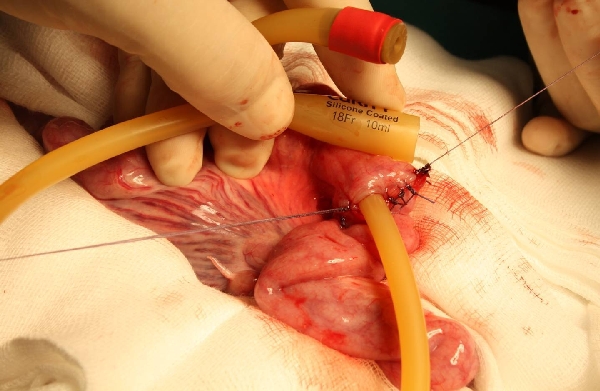|
Back to Annual Meeting Program
Reinforcing the High Risk Intestinal Anastomosis: Experimental Pilot Study
Jana Dziaková*1,2, Iris Sanchez Egido1,2, Diego Sierra Barbosa1,2, Julio Mayol1,2
1Servicio de Cirugia I, Hospital Clinico San Carlos, Madrid, Spain; 2Universidad Complutense, Madrid, Spain
Introduction:
Anastomotic leakage is one of the causes of increased morbidity and mortality in gastrointestinal and colorectal surgery and it is also associated with elevated costs. The aim of this study was to investigate the effect of synthetic hydrogel sealant and a fibrin sealant on incompetent anastomosis in animal experimental model.
Materials and methods:
After obtaining approval from our Animal Ethics Committee, ten pigs were anesthetized using a standard protocol. A midline laparotomy was performed and the terminal ileum identified. Subsequently the intestine was completely sectioned 30 cm proximal to the ileocecal valve. All hand-sewn end-to-end anastomoses were performed by the same surgeon, using interrupted absorbable (3-0 polyglactine 910) sutures and leaving an orifice of 18French in the suture line (as shown in Fig 1). Animal were randomized to the application of a synthetic sealant (polyethylene glycol, group I) or fibrin sealant (group II) on the defect and the suture line. Animal were postoperatively followed for 7 days and prematurely sacrificed if sepsis developed. Otherwise, they underwent a second surgery for revision and the anastomosis was isolated and removed for subsequent histological examination. Fischer’s and Student’s t test was used for statistical analysis. P<0.05 was considered significant.
Results:
Preoperative data was comparable between groups, with no statistical difference.
No septic complications developed in any of the study subjects. Only one animal presented a contained wound dehiscence. On the second surgery, macroscopic findings showed no difference between the 2 groups: There was no evidence of diffuse purulent peritonitis or bowel obstruction. One contained anastomotic leak was found in each group (1/5 vs. 1/5, NS). Adhesions between intestinal loops were found 4 animals: 2 in group I and 2 in group II (2/5 vs. 2/5, NS). An inflammatory mass, containing the leak appeared in 1 case (0/5 vs. 1/5, NS). Microscopically, the local inflammatory response, with granulation tissue and local peritonitis was similar in both groups. Continuity of the mucosal layer was observed in 4 of 10 samples, similar in both groups (2/5 vs. 2/5, NS). Epithelial inclusions in the anastomotic line was found in 1 case in group I and in 3 cases in group II (1/5 vs. 3/5, p=0,26).
Discussion:
We present a preliminary study describing a new model of incompetent anastomosis in a large animal, designed to study the effect of sealants and glues on intestinal healing. Our findings show that this is a viable model and that both synthetic and fibrin sealant may be useful in reinforcing incompetent anastomoses. Further studies are needed to understand the role of these products in the prevention of anastomotic leaks.

Back to Annual Meeting Program
|


